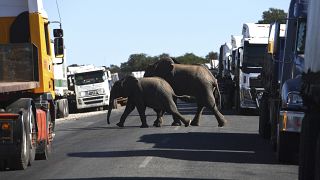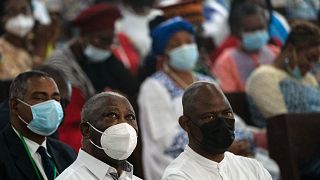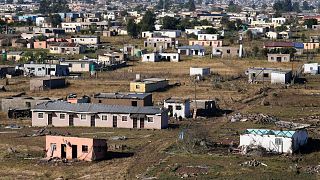Ivory Coast
In Ivory Coast a group of conservationists and veterinarians are moving this increasingly endangered forest elephant to an area where the animal is less likely to be targetted by poachers.
Scientists have been using DNA testing to track how ivory traffickers are operating.
As few as three major criminal groups are responsible for smuggling the vast majority of elephant ivory tusks out of Africa, according to a new study.
They've develop a combined genetic and statistical method to determine the origin of poached ivory and they are collaborating with the Interpol Working Group on Wildlife Crime to investigate the origins of all major ivory seizures in the recent past.
Researchers used analysis of DNA from seized elephant tusks and forensic evidence such as phone records, license plates, financial records and shipping documents to map trafficking operations across the continent and better understand who was behind the crimes.
The study was published (Monday 14 February) in the journal Nature Human Behavior.
They've identified key locations where ivory is poached, packed in shipping containers, then moved by truck or rail to port cities – and how traffickers have shifted operations over time in response to law enforcement.
Current trafficking hubs exist in Kampala, Uganda; Mombasa, Kenya; and Lome, Togo.
Co-author Professor Samuel Wasser from the University of Washington says the focus has been on large shipments of over half a metric ton.
They have been tracing what they describe as "transnational criminal organizatons" or TCOs.
Wasser says the contraband is moved in large amounts in shipping containers to ports outside of the countries where the poaching happens.
He says: "In almost all cases, except for early on, the ivory was being exported out of a different country from where it was poached, which means that, you know, the poachers are on foot and they only have as much as they can carry, and middlemen were going buying the ivory, moving it up to a neighbouring country where it was being consolidated by these big transnational criminal organisations, that l'll call TCOs, and being shipped out of the country. And so it was those TCOs that we believe were the choke point in the trade, if you can, because once the transnational criminal organisations, moving contraband tend to move these large shipments on ships in containerised on ships as marine cargo. And 70 percent of the world's products are moved on ships, so there's literally a billion containers moved around the world each year. So if you are a transnational criminal, all you got to do is get your consignment through customs into transit and you pretty much got it, made it so hard to trace it once that happens."
Wasser says the poaching is concentrated in a few carefully chosen areas.
"To be a poaching hotspot, you have to be a big area with a huge number of elephants, so you can keep going back to them over and over again. So for example, the biggest hot spot that we saw was in the Selous Game Reserve in southern Tanzania, which is 55,000 square kilometres. It's the largest protected area in Africa and the poachers operating in there know that area very well because they they grew up there and trying to find those poachers in an area of that size is extremely difficult and then when you do find them, they only have as many tusks as they can carry. So it's not a very big haul and there's plenty of other poachers that can replace them," says Wasser.
Each year, some 500 metric tons (1.1 million pounds) of poached elephant tusks are shipped from Africa, mostly to Asia.
Wasser hopes the findings will help law enforcement officials target the leaders of these networks instead of low-level poachers who are easily replaced by criminal organizations.
He says: "If you can stop the trade where the ivory is being consolidated and exported out of the country, those are really the key players that you need to get there, the choke point and our work has shown that they have been operating for decades. They are the people that the poachers depend on to buy their ivory. So if you can get them, you can break the whole trade."
According to Wasser all of the vast illegal trade in ivory is being organized by a very few well protected criminals.
"These TCOs are very few in number, there may be as few as one in a given country and when you look at the movement from Tanzania to Kenya to Uganda and all the connections between them, it may be that it's really one big organisation that's driving the whole thing, or three independent ones that are so tightly connected they're operating as one," he says.
For the past two decades, Wasser has fixated on a few key questions: "Where is most of the ivory being poached, who is moving it, and how many people are they?"
He works with wildlife authorities in Kenya, Singapore, Hong Kong, Malaysia and elsewhere, who contact him after authorities intercept ivory shipments.
He flies to the countries to take small samples of tusks – just 1.5 inches (4cm) by 1.5 inches – to analyze the DNA.
Sample by sample, year by year, he has amassed the world's largest collection of ivory DNA – taken from the tusks of more than 4,300 elephants trafficked out of Africa between 1995 and today.
The aim is to allow prosecuting authorities to understand how one seizure in one country might be tied to a multitude of others.
At the moment he believes short term thinking is a serious problem when it comes to stamping out the trade altogether.
"They just want to get it to the prosecution and then say, look, we did a great job, boom, we got these guys. But that is a Whack-A-Mole problem because you're not really getting at the big network, moving them and you end up getting low level people that are involved with that, that you can connect to the shipment, not the big guy. And what we're trying to do is change that investigation so that when a seizure is made, that's not considered the end, that's considered the beginning," says Wasser.
Wasser says their new techniques give police a vast amount of information which allows them to see a bigger picture.
He says: "That also stops the poaching because the poachers depend on that guy who has been again operating for decades to be there to buy their ivory. How do I know they've been operating for decades because we have seizures made in 2005 that has a that has a tusk that matches, has several tusks that match close relatives in a seizure made as far away as 2019. Same guys there over and over again. And these are protected individuals in these countries. They're very well connected and and they are the ones that we really need to get."
In 2004, Wasser demonstrated that DNA from elephant tusks and dung could be used to pinpoint their home location to within a few hundred miles.
In 2018, he recognized that finding identical DNA in tusks from two different ivory seizures meant they were harvested from the same animal – and by definition, the same poaching syndicate.
The new research expands that approach to identify DNA belonging to elephant parents and offspring, as well as siblings - and led to the discovery that only a very few criminal groups are behind most of the ivory trafficking in Africa.
Because female elephants remain in the same family group their whole life, and most males don't travel too far from their family herd, the researchers hypothesize that tusks from close family members are likely to have been poached at the same time, or by the same operators.
Such genetic links can provide a blueprint for wildlife authorities seeking other evidence – cell phone records, license plates, shipping documents and financial statements – to link different ivory shipments.
Special Agent John Brown III of the Office of Homeland Security Investigations, who has worked on environmental crimes for 25 years has told Associated Press: "if you're looking simply at that one seizure, you only have only block of physical evidence … you wouldn't necessarily identify a transnational criminal organization behind that trade. But the scientists' work identifying DNA links can alert us to the connections between individual seizures," says Brown, who is also a co-author of the study.
The study's authors say their findings are the backbone of multiple multinational investigations that are ongoing.
Traffickers that smuggle ivory also often move other contraband, the researchers found.
A quarter of large seizures of pangolin scales – an endangered anteater-like animal – are co-mingled with ivory, for instance.
Africa's elephant population is fast dwindling, from around 5 million elephants a century ago, to 1.3 million in 1979.
The total number of elephants in Africa is now estimated to be around 415,000.
A ban on international commercial ivory trade enacted in 1989 hasn't stopped the decline.
Between 2007 and 2014, the elephant population in Africa declined by 30 percent or an estimated 144,000 elephants, largely due to poaching.
Each year, some 500 metric tons (1.1 million pounds) of poached elephant tusks are shipped from Africa, mostly to Asia.











02:14
Scientists find way to identify elephant ivory disguised as legal mammoth ivory
01:05
Zimbabwe to cull 50 elephants, distribute meat to locals
01:50
Sierra Leone: popular chimpanzee sanctuary under threat from encroachment
01:30
Ivory Coast opposition call for election reform ahead of vote
00:31
Mauritanian economist elected African Development Bank president
00:10
Elephant spotted in Senegalese park gives hope to conservationists